Ricoh KR-5 Super II
aka - Ricoh XR-8
This camera manual library is for reference
and historical purposes, all rights reserved.
This page is copyright© by
 . M. Butkus, N.J.
. M. Butkus, N.J.
This page may not be sold or distributed without the
expressed permission of the producer.
If you find this manual
useful,
how about a donation of $3 to:
M. Butkus, 29 Lake Ave.,
High Bridge, NJ 08829-1701
and send your
e-mail address
so I can thank you.
Most other places would charge
you $7.50 for a electronic copy
or $18.00 for a hard to read Xerox copy.
This will help me to continue to host this site,
buy new manuals,
and pay their shipping costs.
It'll make you feel better, won't
it ?
If you use Pay Pal, use the link below.
Use the above address for a check, M.O. or cash.
Back to my main camera manual page
Problems
opening PDF files or printing problems
- click here
RICOH KR-5 SUPER II PDF
RICOH KR-5 SUPER II
Bedienungsanleitung
RICOH KR-5 SUPER II Mode D'Emploi
-
- - - - - - - - - - - - - - - - -
RICOH KR-5 SUPER II Manual de Instrucciones
RICOH KR-5 SUPER II
istruzioni per l'uso
Click here for Ricoh KR-5 Super II PDF
version of this manual
from HTML File
- better printing

[Webmaster: The main difference with this camera and the KR-5 (1/500 shutter max)
and KR-5 Super is the TTL wide open metering and the 1/2000 shutter]
Congratulations on your selecting of RICOH KR- 5
SUPER II. This is a compact and lightweight SLR camera with full open aperture
TTL exposure metering. Enjoying good photography becomes far easier with this
camera. It just requires releasing the shutter on your focused subject at the
setting which the LED displays green. With carefully reading this booklet, you
can enjoy easy-to-take highest quality photography for the years ahead.
DESCRIPTION OF PARTS
|
1. Shutter Speed Dial
2. Shutter Release Bettors
3 Film Advance Lever
4. Frame Counter
5. Strap Hook
|
6. Hand Grip
7. Self-timer Lever
B. Lens Release Button
9. Hot Shoe
10 Film Rewind Crank |
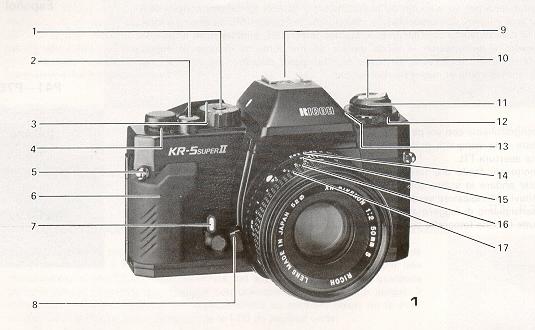
|
11. Film Rewind Knob/Film compartment
Opening Knob
12. Film Speed Dial
13. Film Speed Index
14. Aperture Ring
15 Depth-of-field Scale (Not on all lenses)
|
16 Distance Scale
17 Focusing Ring
18. Viewfinder Eyepiece
19. Rewired Shaft
20. Film Chamber |
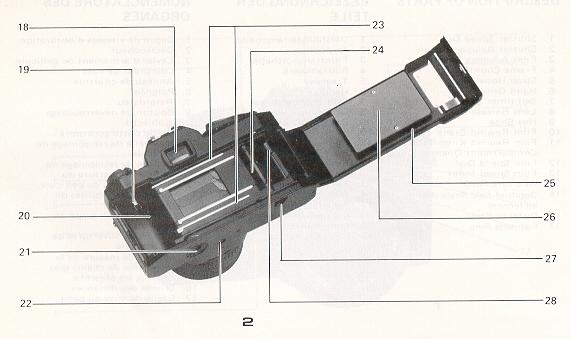
|
21. Battery Compartment Cover
22. Tripod Socket
23 Film Guide Bars
24. Sprocket
|
25. Back Cover
26 Film Pressure Plate
27. film Rewind Button
28. Film Take up Spool
|
Inserting Batteries

|
1. Turn the
battery compartment cover (21 ) counter clockwise using a coin or something similar.
2. Two LR44 type alkaline batteries or two SR44
type silver batteries are used with this camera.
3 Place the batteries so that both positive (+)
sides are at the top of the compartment
4. Turn the battery compartment cover
clockwise until it closes firmly.
|
Battery Check
1. Move the film advance lever (3) to the ready position.
2. Partly press the shutter release button (2)
Now the exposure metering system is switched on. Next, look through the viewfinder When one of three LED lamps ( +, 0
or - ) lights, then battery condition is satisfactory. If
no lamp lights, the batteries need replacing or have been (loaded incorrectly.
3. Renew both batteries as necessary.
4. When not using of the camera, always return
the film advance lever to the original position to prevent accidentally releasing the shutter.
Loading film
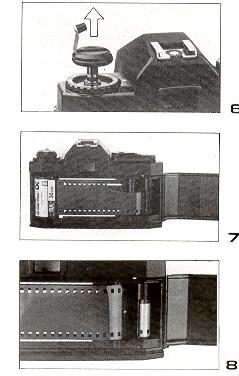
|
1. To open
the back cover (25), fold out the film rewind crank (10), then pull knob (11) out. When the back cover opens, the frame counter (4) automatically resets
to "S''.
2. Insert the film cassette into the film
chamber so that the projecting end of the film cassette is downward. Do this in a place away from direct sunlight.
3. Fold out and lift up the film rewind
crank (10) Then rotate the crank carefully while pushing it down lightly
until the film locks on the film rewind shaft (19)
4. Return the film rewind crank to its original position
5. Insert the film leader into the groove
of the take-up spool (28) and place it so that the film perforations engage with the spool teeth.
|

|
6. Check that the film perforations engage
properly with the teeth of sprocket (24) and the film slides smoothly along the
film guide bars (23) by operating lightly the film advance lever (3) to advance
the film.
7. Turn the film rewind crank gently in
the direction of the arrow to properly tension the loaded film, Stop
turning the crank when it becomes stiff, and return the crank to its
original position.
8. Close the back cover and push it until a click is heard.
9. Advance the film a couple of frames,
pressing the shutter release button each time until the frame counter
indicates ''1'' between 0 and 2. (In this case, the film advance lever
should be at the ready position, because the shutter release is
interlocked when the lever is in the stored position). The film rewind
knob rotates each time the film is advanced meaning that the film is
advancing properly. |
Film speed Setting
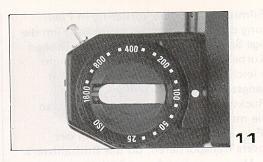
|
1. Film speed is indicated on the outside of the film package or in the film instructions
|
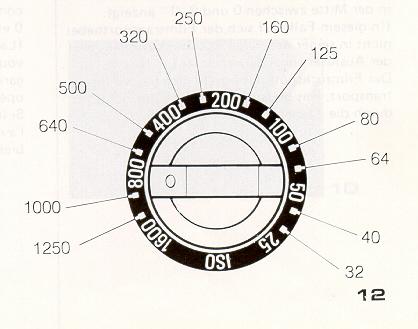 |
2.
Set the film speed index (13) by turning the film speed dial (12) according to the value indicated by the film. |
Exposure Setting (shutter speed priority)
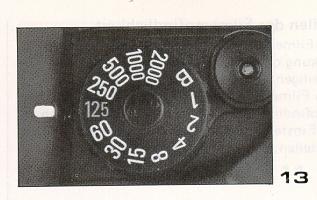
|
1. Place
the film advance lever (3) in the ready position and turn the shutter speed
dial so that the indicator white line aligns with the desired shutter speed
value. If the dial is set at the intermediate positions of the index,
shutter speed will be incorrect Be sure that the dial clicks at the position
where the white line aligns with the desired value. With setting at "B"
(bulb) position, exposure monitoring is impossible.
|
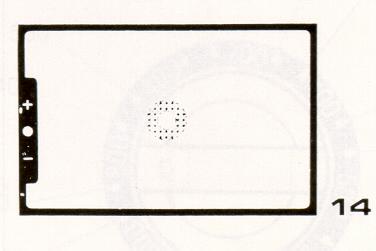 |
2. With brighter subjects, fast moving
subjects or with the higher value film speed of the film used, it is recommended
to use higher shutter speeds.
3. In photography using telephoto lenses, use
the highest shutter; speed possible to avoid camera movement affecting your
pictures. Generally selecting a higher shutter speed value than the focal length
of the lens is recommended, i.e. 1/250 sec shutter speed is
recommended for a telephoto lens with 135 mm focal length, and 1/500 see
for 300 mm focal length.
|
4. Recommended shutter speed with ISO 100/21° film and standard 50mm focal length lens under typical situation is as follows:
| Subject |
Shutter speed |
| Stationary subjects |
1 to 1/15 |
| In subdued light |
1 to 1/15 |
| Indoors in normal conditions |
1/30 to 1/60 |
| Outdoors on a fine day |
1/125 to 1/250 |
| Seaside in midsummer |
1/500 to 1/2000 |
| mountain area with snow |
1/500 to 1/2000 |
| Fast moving subjects |
1/500 to 1/2000 |
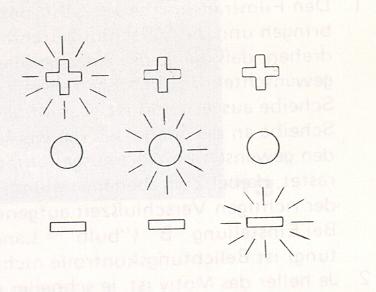
|
5. To monitor exposure, partly press the shutter release button (2), turn the
aperture ring (14) until the green "0" mark lights in the viewfinder.
|
When the red mark
lights, meaning that the exposure is too great, turn the aperture ring in
the direction to greater (higher number) F-stop. If the red (
- ) mark shows, exposure is below what is necessary, so turn the
aperture ring (14) to a smaller (lower number) F-stop value.
Exposure setting (Aperture priority)

|
1. Place
the film advance lever (3) in the ready position and turn the aperture ring
(14) until the index on the lens barrel indicates the desired f/value.
2. The suitable aperture value changes
according to the brightness of the subject, the depth-of-field desired or
film speed of the film in use, and typical settings of the aperture with
ISO 100/21°
(ASA100/DIN21 ) film are as follows: |
| Subject |
F-value |
| In subdued light |
F/1.4 to F/2 |
| To narrow depth of-field |
F/1.4 to F/2 |
| Indoors in normal condition |
F/2 to F/4 |
| Outdoors on a cloud day |
F /4 to F /8 |
| Outdoors on a fine day |
F/8 to F/11 |
| Seaside in midsummer |
F/11 to F/16 |
| Mountain areas with snow |
F/11 to F/16 |
3. To monitor the exposure, partly press the
shutter release button (2) and turn the shutter speed dial until the green (
0 ) mark lights in the viewfinder. If the red ( +
)mark lights, turn the shutter speed dial to the higher shutter speed setting
and if the red ( - ) mark lights, then turn the shutter
speed dial to the lower setting. When the green ( 0 ) mark
lights at intermediate positions between click, first set the dial at a click on
either side and make fine control by operating the aperture ring afterwards.
Holding Camera
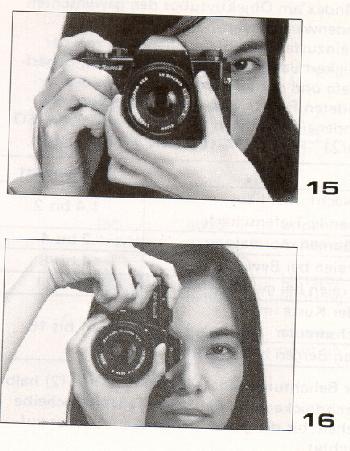
|
1. Hold the camera in the palm of the left hand so as to turn the (lens focusing ring
(17) easily with fingers.
2. Hold the camera body lightly by holding grip (6) and place your right forefinger lightly on the shutter release button.
3. Press your left elbow lightly against you,
body and look through the viewfinder eyepiece (18) to steady the camera against your face. Then relax your right arm holding the grip.
4. With telephoto lenses or lower shutter
speeds, it is recommended to use a tripod and/or remote shutter release control cable.
|
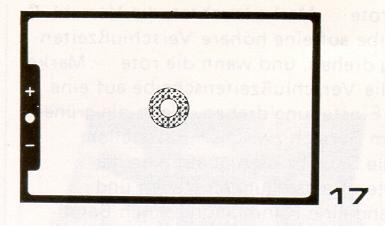
|
1. Focusing
is done by observing through the circled area in the center of the
viewfinder screen Within the circle is the split image spot prism and around
the circle there is the microprism collar.
2. In focusing through the split image spot,
when the image divided horizontally is brought into alignment by focusing, focus
in correct. When the upper and lower half images do not align, it is out-of-focus.
|
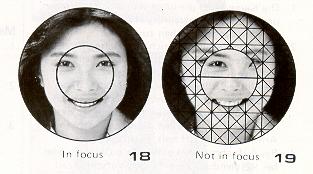
|
3. To focus through the microprism collar
outside center spot, a broken shimmering image is seen when it is out-of-focus
and correct focus is at the setting in which the image becomes clear and sharp.
4. Focusing through the entire matte surface of
the viewfinder is also possible. In this case, at the setting where the sharpest
image is obtained, precise focusing is secured .
|
5. Choose the most effective focusing
method from the above according to the shooting situation, such as the lens used, the subject, etc.
Rewinding the film
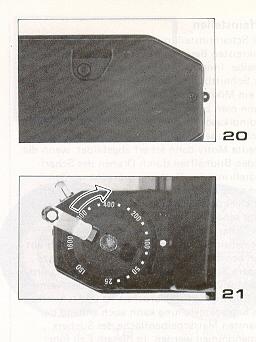
|
1. When the
film advance lever no longer operates smoothly, check the frame counter (4)
display. If the frame counter shows that the all frames of the loaded film
have been exposed, replace the film.
2. Press the film rewind button (27) on the camera base.
3, Fold out the film rewind crank (10) and turn
it in the direction of the arrow,
4. Once the pressure eases, the film is completely wound into the cassette.
|
5. Lift up the film rewind knob (11 ) and pull
it out to open the back cover (25). Now the film cassette can be taken out.
6. Do this in a place away from direct sunlight,
"B" (bulb) Setting
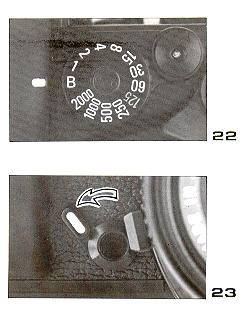 |
1. With the
shutter speed dial ( 1 ) set at "B" position, the shutter will remain open
for as long as the shutter release button (2) is pressed. (Fig. 22)
2 This setting is useful when an exposure
longer than one second is required, such as in landscape photography at
night. Or it can be used for the special effect photography by employing
the flash test button together with very dim light conditions
3. Be sure to use a tripod and/or remote shutter
release control when using this shutter speed setting.
|
Self -Timer
1. Wind the film advance lever (3) and fully turn the self-timer lever (7) counter clockwise.
Now the self-timer is ready to use (fig. 23)
2. Press the shutter release button (2) and the
self-timer operates to release the shutter in
approximately 10 seconds later.
3. Once the self-timer becomes ready it is
impossible to return it manually. So operate it only
when you really need it.
4. The self-timer is very useful when you wish
to include yourself in a picture, or, you can use it
in order to prevent camera movement in shutter releasing instead of using the remote
shutter release control.
Flash Photography
1. You only have to directly fit the flash
unit in the hot-shoe (9).
2 Set the shutter speed dial (1 ) at 1/125 sec. or lower.
3. Set the corresponding aperture value from the
Guide Number (G N.) of your flash unit by operating the aperture ring (14). For
details on how to determine the correct aperture value to use, follow the
instructions given in the manual of your flash unit.
(Mike: If you have an Auto flash, place the
flash in Auto and the flash should have an indicator as to what to set the
F-stop on the lens to. This F-stop will be useful to the auto distances
located on the flash.)
Depth-of -Field
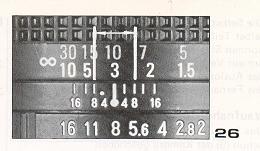
|
1. When you
are focusing on a given subject, objects in the foreground and background
will appear acceptably sharp in the picture. The range in which all objects
appear acceptably sharp in the picture is called ''depth-of-field.'' |
2. To obtain the depth-of-field range at different aperture settings, the depth of-field scale (15)
is used. The depth-of-field scale is positioned between the focusing ring (17) and aperture
ring (14) The distance covered by the range between pairs of the same f/stops on the
depth-of-field scale as the f/value used is the depth-of-field. To obtain the actual distance
values of the depth-of-field, read the values within the range off the focusing scale
3. For instance, when the lens is focused on a subject at a distance of 3 m (9 8 ft.) with the aperture
set at f/8, the depth-of-field can be obtained by using the depth of field scale as follows the
values
on the distance scale corresponding with the f/values shown on the depth-of-field scale are
approximately 2 4 m (7.9 ft.) and 4 5 m (14.8 ft.) respectively. This means that all objects within
the range between 2 4 m (7 9 ft ) and 4.5 m (14 8 ft ) distance can be reproduced acceptably
sharp in the picture with the aperture set at fl8.
Infrared Photography
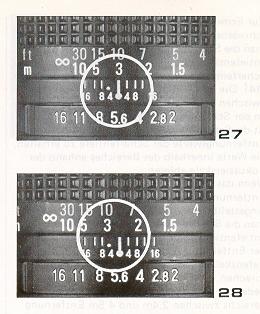
|
1. The dot
mark engraved in red on the depth-of-field scale (15) is the infrared
distance indicator. This is used for reading the distance scale in infrared
photography using infrared film and filters. [Mike: this applies to
Black and White IR films, color focuses as regular film.]
2. First, secure focus in the normal
manner Then, read off the subject distance on the normal distance scale
(16), then align it with the infrared distance indicator.
3 For instance, when you focus on a subject at
3m in the normal manner, read off the value ''3" on the focusing scale and move
the focusing ring until the infrared distance indicator points to ''3''.
|
4 Always use the red filter when attempting infrared photography. For other details concerning infrared photography,
follow the instructions of the infrared film used.
Mounting/Removing the Lens
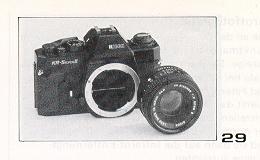
|
1. The lens mounting of this camera is the ''K'' mount All other lenses with a ''K"
mount can be mounted on this camera.
[Mike: as with the other K-mount KR-5's you can use any type of K-mount lens.
2. To mount the lens, after matching the red mark on the camera body with the red mark of the lens barrel, insert the lens in
the camera body and turn the lens clockwise until it clicks. |
3. To remove the lens from the camera body, turn the lens all the way counter clockwise while
keeping the lens release button (8) pressed, then lift it straight out of the mount.
SPECIFICATIONS
| Type:
|
35mm SLR camera with focal plane shutter and TTL metering
with 3 LED display, exposure setting obtained by matching "0" mark.
|
| Film format:
|
24mm x 36mm
|
| Mount type:
|
Bayonet "K" mount
|
| Shutter release:
|
Metal focal plane shutter operating vertically - B to 1 - 1/2000 sec.
|
|
|
|
|
| Flash Synchronization:
|
Hot-shoe, X contact, synchronized at l/125 or lower shutter speed
|
| Viewfinder:
|
Eye-level finder with use of pentaprism image
magnification ratio on the finder 0.86x (with standard 50mm focal length
lens at infinity
field-of-view 93°0 horizontally and vertically to the actual picture area.
Focusing method; Matching the divided image through horizontal split image
prism center spot,
Focusing through microprism collar or entire matte surface is also
possible |
| Displays in viewfinder:
|
red ( + ) mark LED overexposure warning;
green " 0 ", mark LED good exposure indication,
red ( - ) mark LED underexposure warning |
| Exposure metering:
|
Full aperture TTL metering system. Center weighted area measurement
Display overexposure, underexposure warnings and good exposure indication
Desired setting is obtain by matching " 0 "
Mark, (zero method}
Measurement range: ISO 100/21° EV5 (F2,1/8s) -
EV19 (F16,1/2000s)
|
| Film speed setting:
|
ISO 25/15° 1600/33, by 1/3 steps
|
| Film advancing:
|
One frame advance by single-lever action with 135° throw and 30° stand-off Safety mechanism prevents double-frame
advance or double exposure, shutter release button is interlocked with the advance lever stored at unused position |
| Film rewinding:
|
by operating the film rewind knob and film rewind crank, the button returns
automatically to the original position at the completion of film winding |
| Frame counter:
|
Progressive type with auto reset by opening the back cover
|
| Self Timer:
|
Mechanical self-timer, approx. 10 sec duration
|
| Power source: Two
|
1.5V alkaline batteries (LR44} or silver batteries (SR44)
|
| Size and weight:}
|
133 x 85 x 50mm, 410 9 (camera body only)
|


















